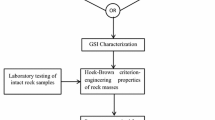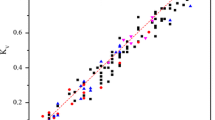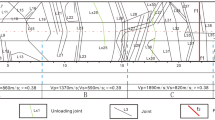Abstract
The Geological Strength Index (GSI) is an important parameter for estimating rock mass properties and can be estimated either through direct observations or by using a quantitative GSI chart or equations. This study aims to discuss the applicability of the RMR89 method and the latest version of GSI|2013 by applying them to a case study and to the data published in the earlier papers. The relevant rock mass properties, including blockiness and discontinuity conditions, of the walls of 15 exploratory adits with a total length longer than 1100 m in a hydropower project in China have been assessed to provide data for the analysis. In addition, a repeat analysis of the earlier published data has been conducted to validate the results derived from the case study. The results show that the GSI values calculated with the RMR89 are generally larger than those obtained from the qualitative GSI chart, with an average magnitude of about five. The GSI values predicted from the values of JCond89 and RQD are consistent with those derived through the qualitative observational method for a medium-quality rock mass but are relatively smaller or larger for a poor-quality (i.e., GSI<45) or a high-quality (i.e. GSI>65) rock mass, respectively. By comparing the results of the RMR89 method and the qualitative GSI chart method and analyzing the classification factors considered by the two methods, two new equations based on the RMR89 system have been developed for estimating the GSI. Their application to the case study and the published data prove that these two equations have higher predictive accuracy than the original RMR89 method and the latest version of GSI|2013. It is expected that the acquisition of more engineering examples will enable the two formulas to be further verified and improved.












Similar content being viewed by others
References
Ali W, Mohammad N, Tahir M (2014) Rock mass characterization for diversion tunnels at Diamer Basha dam, Pakistan – a design perspective. Int J Sci Eng Technol 3(10):1292–1296
Barton N, Lien R, Lunde J (1974) Engineering classification of rock masses for the design of tunnel support. Rock Mech 6:189–236
Anbalagan R, Singh B, Bhargava P (2003) Half tunnels along hill roads of Himalaya—an innovative approach. Tunnel Undergr Space Tech 18(4):411–419
Basarir H, Ozsan A, Karakus M (2005) Analysis of support requirements for a shallow diversion tunnel at Guledar dam site, Turkey. Eng Geol 81:131–145
Bertuzzi R, Douglas K, Mostyn G (2016) Comparison of quantified and chart GSI for four rock masses. Eng Geol 202(2016):24–35
Bieniawski ZT (1989) Engineering rock mass classifications. John Wiley & Sons
Bieniawski ZT (1976) Rock mass classifications in rock engineering. Proceedings of the Symposium on Exploration for Rock Engineering, Johannesburg
Cai M, Kaiser PK, Uno H, Tasaka Y, Minami M (2004) Estimation of rock mass deformation modulus and strength of jointed hard rock masses using the GSI system. Int J Rock Mech Min Sci 41:3–19
Dalgic S (2003) Tunneling in fault zones, Tuzla tunnel, Turkey. Tunnell Undergr Space Tech 18(5):453–465
Dalgic S (2002) A comparison of predicted and actual tunnel behavior in the Istanbul metro, Turkey. Eng Geol 63:69–83
Hoek E, Brown ET (2018) The Hoek-Brown failure criterion and GSI –2018 edition. J Rock Mech Geotech Eng. https://doi.org/10.1016/j.jrmge.2018.08.00
Hoek E, Carter TG, Diederichs MS (2013) Quantification of the geological strength index chart. In: 47th US rock mechanics/geomechanics symposium, American Rock Mechanics Association (ARMA 13–672)
Hoek E, Marinos P (2000) Predicting tunnel squeezing. Tunnels and Tunnelling international. Part 1 – November 2000, Part 2 – December, 2000
Hoek E, Marinos P, Benissi M (1998) Applicability of the geological strength index (GSI) classification for very weak and sheared rock masses. The case of the Athens Schist Formation. Bull Eng Geol Environ 57:151–160
Hoek E, Brown ET (1997) Practical estimates of rock mass strength. Int J Rock Mech Min Sci 34(8):1165–1186
Hoek E, Kaiser PK, Bawden WF (1995) Support of underground excavations in hard rock. Balkema, Rotterdam
Hoek E (1994) Strength of rock and rock masses. ISRM News J:4–16
Irvani I, Wilopo W, Karnawati D (2013) Determination of nuclear power plant site in west bangka based on rock mass rating and geological strength index. J Se Asian Appl Geol 5(2):78–86
Justo J, Justo E, Durand P, Azanon J (2006) The foundation of a 40-story tower in jointed basalt. Int J Rock Mech Min Sci 43:267–281
Marinos P, Hoek E, Marinos V (2005) Variability of the engineering properties of rock masses quantified by the geological strength index: the case of ophioliteswith special emphasis on tunneling. Bull Eng Geol Environ 65:129–142
Marinos P, Hoek E (2001) Estimating the geotechnical properties of heterogeneous rock masses such as flysch. Bull Eng Geol Environ 60:85–92
Marinos P, Hoek E (2000) GSI: a geologically friendly tool for rock mass strength estimation
Marinos V (2019) 2019. A revised, geotechnical classification GSI system for tectonically disturbed heterogeneous rock masses, such as flysch. Bull Eng Geol Environ 78:899–912
Morelli GL (2015) 2015. Variability of the GSI index estimated from different quantitative methods. Geotech Geol Eng 33:983–995
Osgoui R, Ünal E (2005) Rock reinforcement design for unstable tunnels originally excavated in very poor rock mass. Underground space use. In: analysis of the past and lessons for the future, two volume set: proceedings of the international world tunnel congress and the 31st ITA general assembly, Istanbul, Turkey, 7-12 may 2005. CRC press, pp. 291–296
Palmstrom A (1995) RMi—a rock mass characterization system for rock engineering purposes. Ph.D. thesis, University of Oslo, Norway
Pells P (2002) Developments in the design of tunnels and caverns in the Triassic rocks of the Sydney region. Int J Rock Mech Min Sci 39:569–587
Polishook B, Flexer A (1998) Assessment of chalk rock mass in excavations. Bull Eng Geol Environ 57:145–150
Priest SD, Hudson JA (1981) Estimation of discontinuity spacing and trace length using scanline surveys. Int J Rock Mech Min Sci Geomech Abstr 18(3):183–197
Russo G (2009) A new rational method for calculating the GSI. Tunn Undergr Space Technol 24:103–111
Santa C, Gonçalves L, ChaminéH I (2019) A comparative study of GSI chart versions in a heterogeneous rock mass media (Marão tunnel, North Portugal): a reliable index in geotechnical surveys and rock engineering design. Bull Eng Geol Environ. https://doi.org/10.1007/s10064-019-01481-7
Singh JL, Tamrakar NK (2013) Rock mass rating and geological strength index of rock masses of Thopal-Malekhu river areas, Central Nepal lesser Himalaya. Bull Dept Geol 16:29–42
Sonmez H, Ulusay R (2002) A discussion on the Hoek-Brown failure criterion and suggested modifications to the criterion verified by slope stability case studies. Yerbilimleri (Earthsciences; http://www.yerbilimleri.hacettepe.edu.tr/no26/yb26txt6.pdf), 26, 77-99
Sonmez H, Ulusay R (1999) Modification to the geological strength index (GSI) and their applicability to stability of slopes. Int J Rock Mech Min Sci 36:743–760
Wang Y, Aladejare AE (2016) Evaluating variability and uncertainty of geological strength index at a specific site. Rock Mech Rock Eng 49(2016):3559–3573
Winn K, Ngai L, Wong Y (2019) 2019. Quantitative GSI determination of Singapore’s sedimentary rock mass by applying four different approaches. Geotech Geol Eng 37:2103–2119. https://doi.org/10.1007/s10706-018-0748-8
Zhang Q, Huang X, Zhu H, Li J (2019) Quantitative assessments of the correlations between rock mass rating (RMR) and geological strength index (GSI). Tunn Undergr Space Technol 83(2019):73–81
Funding
This research was financially supported by the Fundamental Research Funds for the Central Universities, CHD (No. 300102269202).
Author information
Authors and Affiliations
Corresponding author
Rights and permissions
About this article
Cite this article
Song, Y., Xue, H. & Ju, G. Comparison of different approaches and development of improved formulas for estimating GSI. Bull Eng Geol Environ 79, 3105–3119 (2020). https://doi.org/10.1007/s10064-020-01739-5
Received:
Accepted:
Published:
Issue Date:
DOI: https://doi.org/10.1007/s10064-020-01739-5




